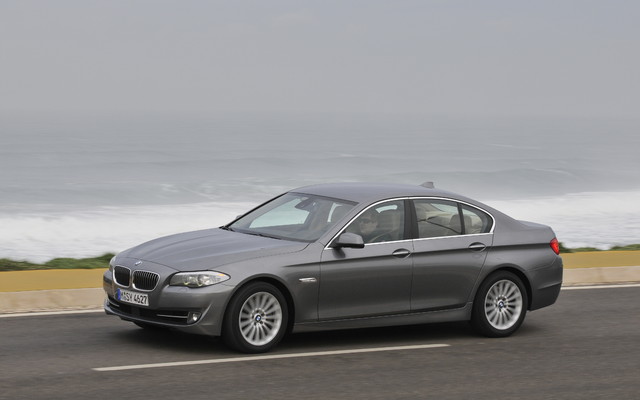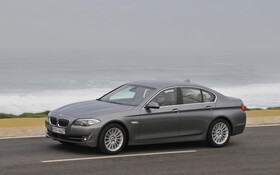2011 BMW 5 Series: The 6th generation
Estoril, Portugal – The 2011 model year marks the beginning of the sixth generation of the BMW 5 Series that will arrive in Canada in March 2010 with the 535i and 550i models. Since the arrival of the 5 Series in 1972, BMW has sold more than 5.5 million of its mid-range sedan worldwide, making it one of the most important models in the Bavarian manufacturer’s product line. At the global launch of this new sedan, we had the chance to meet the 535i and its new six-cylinder, 300 hp turbocharged engine, known internally as N55, which is replacing the N54 twin-turbocharged straight-6 engine that previously equipped the 535i.
One turbo instead of two
This new engine was developed to reduce fuel consumption and emissions and becomes the official primary engine of the 5 Series. The main difference between the previous engine and the new one is the turbochargers: the new engine (N55) equipped with only one turbo that includes two distinct entrances (Twin-Scroll) that help reduce the length of the exhaust manifold up to the catalytic converter thereby guaranteeing cleaner emissions, especially immediately after ignition, which improves the brand’s record in this regard. In terms of performance, the new single turbo N55 engine features identical statistics to those of the twin-turbo N54 with its 300 horsepower and 300 lbs-ft of torque. The main difference between these two engines is that the new one reaches maximum torque at 1,200 rpm, some 200 rpm faster than the twin-turbo engine. The N54 won’t be completely scrapped however. Revised to offer more power, it’s destined for sportier models like the new BMW 335is, which was designed exclusively for the North American market and will be available as of April in a convertible model and June in a coupe (see the other text on the new 335is). Note that the new 5 has an eight-speed gearbox to improve fuel consumption and reduce emissions, and that it’s possible to control it in manual mode using shifters on the wheel.
Adaptive Drive system: Personal settings
On the track at Estoril, the new 535i demonstrates remarkable balance and surprising agility in sport conditions, even though that isn’t its main purpose. The optional Adaptive Drive system has a lot to do with its sport capabilities, since it allows you to select “Sport” and “Sport +” modes to benefit from a faster response from the gas and steering, firmer shock rate from the suspensions and a less premature intervention of the electronic stability control. “Normal” and “Comfort” modes should be used for a more relaxed ride or when you don’t want to rattle your passengers. Thus, the 5 Series’ handling adapts to the driver’s wishes at the touch of a button, courtesy of its advanced electronics. To that, we can add active steering that makes it so that the rear wheels pivot in the same direction as the front wheels up to 2.5 degrees when the car is travelling at more than 60 km/hr thus guaranteeing good stability when changing lanes at high speed. When the vehicle is going less than 60 km/hr, the rear wheels pivot in the opposite direction to that of the front wheels, facilitating parking this new sedan, which is 40 mm longer than the old model. Unlike the previous generation 5, the new model has a double-wishbone front suspension as well as a new rear suspensions made up of an integral V axle these two features help improve the new 5’s comfort and handling better.
The same frame as the 7 Series
The new 5’s larger dimensions can be explained by the fact that it shares its platform and suspensions with the bigger 7 Series. Moreover, the most striking aspect of this transformation is the wheelbase, which has been increased by 80 mm compared to the previous model. On the road, the new 5’s handling really comes close to that of the 7, especially when in it’s in “Comfort” and “Normal” modes. The contribution of the active steering also makes its presence felt on the typical winding curves of European mountain roads since the pivoting of the rear wheels in turns gives the impression that you’re driving a shorter, more agile car.
As for style, the link with the 7 Series is confirmed by the line on the door handles that starts at the front wheel rather than from the front end as is the case with the 7. Moreover, this line becomes thicker near the 5’s tail end in order to highlight its more dynamic personality. The two-nostril front grille is both lower and larger. On board, the asymmetrical central console is turned toward the driver at a seven-degree angle, which defines the more active character of the 5.
BMW Canada didn’t release pricing on its new sedan or the numerous options and option packages that are typical to the brand. Among the new features, note that Park Assistant is available on option, which helps the car park automatically without the driver turning the steering wheel, just like the Lexus LS and the recent Prius, as well as a Surround View camera system similar to that perfected by Infiniti. The pricing should be available just before this new model arrives on our market in March 2010.












